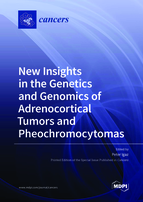New Insights in the Genetics and Genomics of Adrenocortical Tumors and Pheochromocytomas
A special issue of Cancers (ISSN 2072-6694).
Deadline for manuscript submissions: closed (1 September 2021) | Viewed by 44678
Special Issue Editor
Interests: adrenal tumors; adrenocortical cancer; pheochromocytoma; genetics; genomics; microRNAs; non-coding RNA; multiple endocrine neoplasia syndromes; neuroendocrine tumors
Special Issues, Collections and Topics in MDPI journals
Special Issue Information
Dear Colleagues,
Adrenal tumors are common and are often incidentally discovered during imaging (adrenal incidentalomas). Most of the adrenal tumors are indolent hormonally inactive tumors of adrenocortical origin, but hormonally active adrenocortical tumors (primary aldosteronism, Cushing-syndrome), adrenomedullary pheochromocytomas, and adrenocortical cancer have significant morbidity and mortality.
Pheochromocytomas are rare, but exceptional germ-line genetic mutations are found in 30–40% of cases, and somatic mutations are also important. Several novel genes and pathomechanisms have been established in recent years in their pathogenesis.
Major advances have taken also place in our understanding of the genetics of primary aldosteronism and adrenal Cushing’s syndrome. Rare monogenic tumor syndromes (e.g., Li–Fraumeni and Beckwith–Wiedemann syndromes) are known to predispose patients to adrenocortical cancer, and understanding their pathogenesis is important to decipher the pathogenesis of their sporadic counterparts.
Recent studies using high-throughput bioinformatics approaches have contributed to significant progress in genomics and epigenomics of adrenal tumors that involve both the analysis of transcriptome, methylome, miRnome and other non-coding RNA. Novel biomarkers of adrenal malignancy and tumor classification can be developed based on these observations.
The Special Issue aims to cover several aspects of both adrenocortical tumors and pheochromocytomas involving advances in both genetics and epi/genomics.
Prof. Dr. Peter Igaz
Guest Editor
Manuscript Submission Information
Manuscripts should be submitted online at www.mdpi.com by registering and logging in to this website. Once you are registered, click here to go to the submission form. Manuscripts can be submitted until the deadline. All submissions that pass pre-check are peer-reviewed. Accepted papers will be published continuously in the journal (as soon as accepted) and will be listed together on the special issue website. Research articles, review articles as well as short communications are invited. For planned papers, a title and short abstract (about 100 words) can be sent to the Editorial Office for announcement on this website.
Submitted manuscripts should not have been published previously, nor be under consideration for publication elsewhere (except conference proceedings papers). All manuscripts are thoroughly refereed through a single-blind peer-review process. A guide for authors and other relevant information for submission of manuscripts is available on the Instructions for Authors page. Cancers is an international peer-reviewed open access semimonthly journal published by MDPI.
Please visit the Instructions for Authors page before submitting a manuscript. The Article Processing Charge (APC) for publication in this open access journal is 2900 CHF (Swiss Francs). Submitted papers should be well formatted and use good English. Authors may use MDPI's English editing service prior to publication or during author revisions.
Keywords
- adrenal tumor
- adrenal incidentaloma
- primary aldosteronism
- adrenal Cushing’s syndrome
- adrenocortical cancer
- pheochromocytoma
- malignant pheochromocytoma
- hereditary
- multiple endocrine neoplasia syndromes
- susceptibility gene
- pseudohypoxia
- transcriptomics
- methylome
- microRNA
- miRnome
- non-coding RNA
- genetics
- epigenetics
- genomics
- epigenomics
- biomarker
- tumor classification







